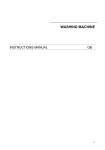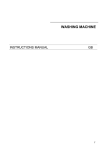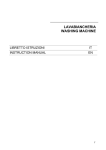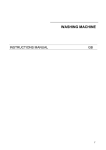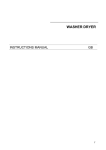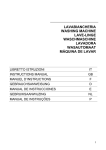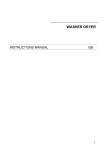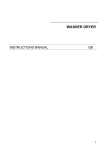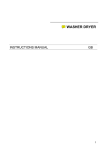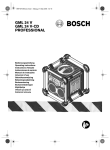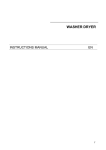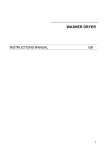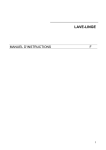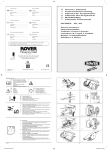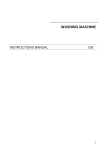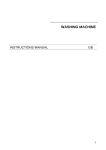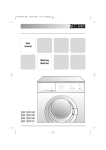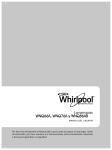Download Smeg STA120 washing machine
Transcript
LAVABIANCHERIA WASHING MACHINE LAVE-LINGE WASCHMASCHINE LAVADORA WASAUTOMAAT LIBRETTO ISTRUZIONI IT INSTRUCTIONS MANUAL GB MANUEL D’INSTRUCTIONS F GEBRAUCHSANWEISUNG D MANUAL DE INSTRUCCIONES E GEBRUIKSAANWIJZING NL 1 I Indice 1. Il nuovo sistema di lavaggio GB Pag. Contents Pag. 3 1. The new washing system 2. Avvertenze per la sicurezza e l’uso 4 2. Safety warnings 23 3. Istruzioni per l’installazione 6 3. Installation instructions 26 4. Descrizione comandi 9 4. Description of controls 28 5. Utilizzazione della macchina 13 5. Using the machine 32 6. Pulizia e manutenzione 7. Avvertenze in caso di anomalie e malfunzionamento Simboli Pannello Comandi 18 6. Cleaning and maintenance 37 20 7. Troubleshooting 39 118 Control Panel Symbols 119 Contrassegno WEEE 119 WEEE mark 120 F Sommaire 1. Le nouveau système de lavage 22 D Pag. Inhaltsverzeichnis Pag. 41 1. Das neue Waschsystem 60 2. Avertissements pour la sécurité et l’utilisation 42 2. Sicherheits- und Gebrauchs-Hinweise 61 3. Instructions pour l’installation 44 3. Installations-Anweisungen 64 4. Description des commandes 47 4. Beschreibung der Schaltungen 67 5. Utilisation de la machine 51 5. Gebrauch der Waschmaschine 71 6. Nettoyage et entretien 7. Avertissements en cas d’anomalies de fonctionnement Symboles Tableau De Board 56 6. Reinigung und Wartung 76 58 7. Hinweise bei Betriebsstörungen 78 119 Symbole Bedienungsblende 119 Marque WEEE 120 WEEE Zeichen 120 E Índice NL Pag. Inhoudsopgave Pag. 1. El nuevo sistema de lavado 80 1. Het nieuwe wassysteem 99 2. Advertencias para la seguridad y el uso 81 2. Aanwijzingen voor de veiligheid en het gebruik 100 3. Instrucciones para la instalación 83 3. Aanwijzingen voor de installatie 103 4. Descripción de los mandos 86 4. Beschrijving van de bediening 106 5. Utilización de la máquina 90 5. Gebruik van de machine 110 6. Limpieza y mantenimiento 7. Advertencias en caso de anomalías de funcionamiento Simbolos Panel De Mandos 95 6. Schoonmaak en onderhoud 115 97 7. Aanwijzingen bij storingen 117 119 Bedieningspaneel Symbolen 119 120 Markteken WEEE 120 Marca WEEE 2 GB 1. THE NEW WASHING SYSTEM This new washing machine is the outcome of years of research. The leading-edge design and the quality of the production processes used to manufacture this product ensure it will give you many years of excellent service. Its concept satisfies all current and future washing requirements. Its low water, power and detergent consumption help protect the environment and reduce running costs to a minimum. Water and power consumption has been reduced in all programmes. These results were achieved by means of a special washing system valid for all programmes and all fabrics. The drum is fitted with three external vanes that keep the water constantly circulating, thereby offering intensive and uniform washing whilst consuming less water. This ensures your laundry is washed and treated with utmost care. The new washing system is so effective that normally dirty laundry can even be cleaned without a pre-wash cycle. Washing times have also been reduced. Pre-washing is only recommended for very dirty laundry. Please read the operating instructions with care in order to take full advantage of all the features offered by this washing machine. Warning! Please read all the instructions contained in this manual in order to understand how to operate this appliance correctly and safely. This manual is divided into paragraphs which provide a step-by-step description of all the functions of the appliance. The instructions are easy to understand and are accompanied by detailed illustrations. This manual provides a quick and easy reference for answering all your questions concerning the use of your new washing machine. Keep this manual near the machine for future consultation. When selling or moving the appliance, make sure this manual remains with the machine. 22 2. SAFETY WARNINGS Attention! These warnings are given for safety reasons. Please read them carefully before installing and using the appliance. This manual forms an integral part of the appliance and must therefore be kept intact together with the machine. Before using the appliance, carefully read all the instructions contained in this manual. Installation must be performed by a qualified technician in compliance with the regulations in force. It has been designed for domestic use and complies with EEC Directives 72/23, 89/336 (including 92/31 and 93/68) currently in force. The appliance is designed for the following purpose: washing linen or fabrics declared by their manufacturers to be suitable for machine washing by means of an appropriate symbol. Any other use shall be considered improper. The manufacturer declines all responsibility for uses other than those described above. The name plate featuring the technical data, serial number and markings is visibly positioned on the inner edge of the door. This name plate must never be removed. Do not leaving discarded packaging materials unsupervised within the home. Separate the various packaging materials and take them to the nearest sorted waste collection centre. The electrical and plumbing work require to install the appliance may only be performed by qualified technicians. The appliance must be provided with an earth connection in accordance with the electrical safety regulations in force. The manufacturer declines all responsibility for damage to persons or property resulting from failure to earth the appliance or from a defective earth connection. If the appliance is not connected to the electrical power supply by means of a plug, it is necessary to install an isolation switch with a contact opening gap of at least 3 mm. The plug on the power cord and the corresponding socket must be of the same type and must conform to the regulations in force. Check that the voltage and frequency of the electrical power supply match the ratings on the name plate. Avoid using adaptors or shunt connections. Never unplug the appliance by pulling the power cord. The machine is only disconnected from the electrical power supply if the plug has been removed from the socket or if the general switch has been turned off. After installation, the plug must remain accessible. The appliance must always be connected to the water supply with new hoses (supplied with the appliance). Old hoses must never be reused. Make sure the appliance does not lie on the power cord. Before use, make sure the tub assembly has been released (see instructions). If the tub assembly has not been released, it may damage the appliance or adjacent furniture or appliances during the spin cycle. The washing machine must never be used in vehicles, on ships or planes, or in special environmental conditions such as explosive or corrosive (powder, vapour and gas) atmospheres or near explosive and/or corrosive liquids. Do not install the washing machine in areas subject to frosting. Frozen pipes may burst under pressure. Make sure that the drain hose is securely attached to the basin and cannot move. If it is not securely fitted, the repulsive force of the water may detach it from the basin and cause flooding. When attaching the hose to the basin, make sure the water drains away rapidly and does not fill the basin up. Do not overload the appliance. Never use detergents containing solvents or chemicals. These may damage the machine and form poisonous fumes. They may also catch fire and explode. 23 Do not wash petrol-soaked garments in the washing machine. Make sure there are no inflammable items (e.g.: lighters, matches, etc.) in pockets before washing. If volatile fluids have been used to clean garments, make sure that the substances have been removed before loading them in the washing machine. Before loading garments for washing, make sure the pockets are empty, the buttons securely fixed and the zips closed. Do not wash frayed or torn garments. The glass of the door will heat up considerably when washing at elevated temperatures. Make sure all the water has drained away before you open the door. If water is present, only open the door after draining it. If in doubt, read the instructions manual. The water in the machine is not drinkable! Swallowing washing machine detergents can cause lesions in your mouth and throat. Before removing laundry from the washing machine, make sure the drum has stopped moving. Always switch off the appliance after use to avoid wasting electricity. Leave the door ajar between one wash and the next in order to keep the gasket in good condition. Prolonged inactivity. If the machine is left inactive for a long period: disconnect the machine from the electricity and water supplies and leave the door ajar to prevent bad smells from forming. In the event of a fault, never attempt to repair the machine yourself. Disconnect the appliance from the electrical power supply and shut off the water tap. Then call a qualified technician. Repairs may only be performed by qualified technicians. Repairs performed by unqualified people may be hazardous for users. Obsolete appliances must be rendered unusable: make sure that the door cannot be closed (to prevent children from getting trapped inside while playing and risking their lives) and cut off the power cord after unplugging it. The appliance must then be taken to a sorted waste collection centre. This appliance is intended for use by adults. Do not allow children to tamper with the controls or play with the washing machine. Do not allow children to approach the appliance while it is working. Keep children away from the appliance. Small animals or children may get inside the washing machine. Always check the inside of the drum before use and do not allow children to play with the appliance. Packaging materials (plastic bags, polystyrene, metal profiles, etc.) must not be left within reach of children. Keep children away from the machine when the door or detergent tray is open; the appliance may contain residues of detergent which can cause irreversible damage to the eyes, mouth and throat, as well as possible death by suffocation. Important ! This appliance is easy to use. In order to obtain the best results, however, read this manual with care and follow all the instructions before starting. The manual gives instructions and useful advice on how to install, use and service the appliance correctly. The manufacture declines all responsibility for damage to persons or property resulting from failure to observe the above precautions, from tampering with even just a single component of the appliance, or from the use of unoriginal spare parts. 24 For Great Britain only Warning: this appliance must be earthed. Fuse replacement If the mains lead of this appliance is fitted with a BS 1363A 13amp fused plug, to change a fuse in this type of plug use an A.S.T.A. approved fuse to BS 1362 type and proceed as follows: 1. Remove the fuse cover (A) and fuse (B) 2. Fit replacement 13A fuse into fuse cover 3. Refit both into plug Important: The fuse cover must be refitted when changing a fuse and if the fuse cover is lost the plug must not be used until a correct replacement is fitted. Correct replacement are identified by the colour insert or the colour embossed in words on the base of the plug. Replacement fuse covers are available from your local electrical store. If the appliance is provided with a plugless supply cord: • It is necessary to install in the fixed wiring an all-pole disconnection device having a gap between contacts of at least 3,5mm. After installation the disconnection device has to be easy to reach. • The connection to the mains must be carried out by a qualified technician in accordance to the scheme shown below and the regulations in force L = brown N = blue = yellow-green • In the event of damage to the supply cord, it has to be replaced by the manufacturer or an authorized technical service center in order to avoid any risk. 25 3. INSTALLATION INSTRUCTIONS Important ! The appliance must be installed by a specialised technician according to current regulations. The washing machine is very heavy. Take care when lifting it. 3.1 UNPACKING The inside of the machine comprises a moving assembly which is blocked for transport purposes by the screws (A) located at the rear of the washing machine. 1. Release the assembly by removing these screws with a 13 mm wrench. 2. Remove the screws (A) and relative spacers (B) from the back of the washing machine. 3. To prevent water from entering the machine or people from touching live components with their fingers, close the four holes left open by the screws with the supplied plastic plugs (C). Attention! • Do not turn the machine upside down and do not place it on its side. • Keep all the components used to block the drum assembly as they will be needed if you decide to move the appliance in future. 3.2 POSITIONING AND LEVELLING 1. Place the appliance in the chosen position. 2. Carefully level the machine in all directions using a spirit level and adjusting the height of the feet if necessary. After adjusting the machine, lock the feet with the relative lock nuts. The water inlet and drain hoses can be turned to the right or left depending on installation requirements. Attention! • Carry out this operation carefully to prevent the washing machine from vibrating, generating noise or moving during operation. • If the appliance is installed on a carpeted floor, ensure that the openings on its underside are not obstructed. • Make sure the washing machine does not touch walls, furniture, etc., while it is working. 3.3 WATER SUPPLY CONNECTION 1. Check that inlet pressure lies between the following values: 50-900kPa. For higher pressures, install a pressure reducer. 2. Connect the cold water inlet hose (light blue ring nut) to the cold water tap with a ¾ gas thread, taking care to screw it firmly into place in order to prevent leaks. The water inlet hose must not be bent or crushed and must not be replaced or cut. 3. If a hot water inlet is used, inlet water temperature must not exceed 60°C and the hose with the red ring nut must be connected to the hot water tap. 26 Attention! • If the water pipe is new or has not been used for a long time, let a certain amount of water run before attaching the inlet hose. This stops any deposits of sand and other impurities from clogging the filters used by the machine to protect the water inlet valves. 3.4 DRAIN CONNECTION 1. Insert the end of the drain hose into a drain pipe having an internal diameter of at least 4 cm and a height ranging between 50 and 90 cm, or attach it (using the relative curved plastic profile) to a basin or bath tub. 2. Always check that the end of the drain hose is securely attached in order to prevent the repulsive force of the water from moving it out of position. Attention! • Do not bend or obstruct the hose as this will reduce the flow of water. • Any extensions to the drain hose must not exceed 1 metre, they must have the same internal diameter and must not be obstructed in any way. • In no case may the end of the drain hose be submerged in water. 3.5 ELECTRICAL CONNECTION Before fitting the plug into the socket, make sure that: 1. Input voltage matches that indicated on the name plate attached to the inner edge of the door. 2. The contactor, pressure relief valves, power line and socket are capable of withstanding the maximum rated power input indicated on the name plate. 3. The socket is compatible with the plug supplied with the machine without the need to fit multiple sockets, adaptors or extension leads that could cause overheating or burning. 4. If the socket does not correspond to the supplied plug, replace the socket with one of a suitable type. Attention • The plug must be accessible after installation. • The appliance must be earthed. Plug the machine into a socket fitted with an efficient earth connection. The manufacturer declines all responsibility for damage to persons or property resulting from failure to earth the appliance or from a defective earth connection. Correct electrical connections guarantee maximum safety. • • • • This appliance complies with EEC directive 89/336 of 3.5.89 (modified by EEC directive 92/31) relative to the elimination of radio interference. If the power cord is damaged, only replace it with an original spare part available from our service department. Do not insert/remove the plug from the socket if your hands are wet. Remove the plug from the socket by gripping the plug and not the cord. 27 4. DESCRIPTION OF CONTROLS 4.1 CONTROL PANEL All the commands and controls of the appliance are assembled together on the front panel. Models with fixed spin speed Models with spin speed selector Description of controls A B C D E F G H Open door button ON-OFF and programme selection knob Programme phase LED'S Start-Pause button Options buttons (a list follows in the description of controls) Options enabled LED's Select spin speed or stop with tub full button* Spin speed and stop with tub full LED's* *: for models with spin speed selector 28 A Open door button Press the button to open the door. Chapter 5 – Washing instructions – explains how the door works and how to use it. B This knob lets you: ON-OFF and washing programme selection knob • switch the machine on and off by moving it in either direction from the OFF position (knob indicator vertical) • select washing temperatures within the various fabric sectors by turning it in both directions The knob does not move while the programme is running. The programme is electronically controlled by the machine. C Programme phase LED'S The programme phase LED's indicate which phase of the programme the washing machine is in. The operating phases, shown to the side of the LED's, are the following: START Start This LED indicates that the machine is on but the selected washing programme has not started yet. This is the phase in which the programme select knob has been turned but the “Start/Pause” button has not been pressed yet. WASH Wash End The “Start/Pause” button has been pressed and the washing programme is running. The LED remains on throughout the washing programme. END The LED lights up when the washing programme has finished. It switches off when the machine is switched off (programme select knob to OFF) or when the “Start/Pause” button is pressed again. D “Start/Pause” button Press this button to start the selected washing programme. During washing, press the “Start/Pause” button for about 3 seconds to pause the washing cycle. During the pause, the “Wash” programme phase LED flashes. To resume the washing cycle from where it left off, simply press the “Start/Pause” button again. 29 E Options buttons The options that may be available on the washing machine are shown below. Quick wash Button This button reduces the overall duration of the washing cycle. This option is used to wash small loads or less dirty washing in less time. The bleach stage is skipped when the Quick Wash button is pressed (for models with bleach function). Increase water button This washing machine is programmed to use a certain quantity of water and consume a certain amount of power considered to be sufficient for a normal washing cycle. Only press this button for specific requirements, e.g.: for very delicate fabrics (curtains or wool). The water level for washing and rinsing rises and power consumption for heating increases. Easy-iron button This option reduces creasing on garments at the end of the programme. The machine performs a more delicate spin cycle and moves the garments at the end of the programme. Spin speed for all programmes is 600 rpm. Economy cycle button Press this button for cottons programmes, the machine will perform an extended wash at 35°C (biological step) thereby offering good washing performance combined with power saving. - e The machine then continues the cycle at the selected temperature. N.B.: Press the economy cycle button to obtain a maximum washing temperature of 60° C and the elimination of the prewash. Extra Rinse button In areas with soft water or to improve rinsing, press this button (optional for intensive programmes) to enable the extra rinse function (about 20% more water). No spin button Press this button to eliminate the final spin cycle. The machine stops with the tub full of water and the washing remains soaked. To remove the soaked and dripping washing (drip-dry fabrics) turn the ) and press the knob to the drain and spin position (Drain “Start/Pause” button. The water is automatically drained on all programmes without spinning. Delicates button Press this button to reduce movement of the drum and, consequently, of the washing. Suitable for particularly delicate garments (shirts, silk, curtains, etc.) Half load button If the machine is used with a smaller amount of washing than that indicated in the “Programme Chart”, press this button to save water, detergent and electricity. 1/2 This option should not be used for synthetics or woollens. The recommended doses of detergents should be reduced in proportion to the load. 30 These LED's light up when the relative option button is pressed and indicate that the option has been selected. They remain on until the machine switches off or a different selection is made. F Options enabled LED's G Select spin speed or stop Press this button to select one of three spin speed levels, indicated by the spin speed and stop with tub full LED's. The with tub full button* levels are: H Spin speed and stop with tub full LED's* • maximum speed: the machine spins at the indicated speed • intermediate speed: the machine spins at the indicated speed • final spin disabled and stop with tub full: the machine does not perform all the spins and finishes the washing programme with water in the tub. To drain the water, see the explanations shown in paragraphs 5.10 and 5.14 The LED's indicate the selected speed level. The LED corresponding to the selected level remains on until the machine is switched off or until a new spin speed is selected. (max. speed) (intermediate speed) * For models with spin speed selector 4.2 DETERGENT TRAY This is located to the left of the control panel. Pull it out to open. The tray comprises four compartments which are marked as follows “1”: pre-wash detergent “2”: main wash detergent “ ” or “3”: fabric softener, starch, etc. (treatment products). Compartment “4” is used for bleach. If there is a cover marked , this means that bleach cannot be used with this model of machine. If bleach can be used with the machine, there is no cover. 31 5. USING THE MACHINE 5.1 PREPARING THE WASHING 3. 4. Separate the washing according to the type and colourfastness of the fabrics. Wash whites and coloureds separately. Wash new coloured garments separately for the first time. A label is normally applied to garments giving information on how to clean them. A brief description of these labels is shown below. WASHING BLEACHING Machine wash at max. 90°C Machine wash at max. 60°C Do not bleach Bleaching allowed IRONING Machine wash at max. 40°C Machine wash at max. 30°C Hot iron Warm iron Cool iron Do not iron Petroleum solvent and R113 Do not dry clean DRY CLEANING Machine wash, delicate cycle at max. 60°C Machine wash, delicate cycle at max. 40°C Machine wash, delicate cycle at max. 30°C Any solvent Any solvent except trichloroethylene DRYING Hand wash Do not wash High temperature Less than 60°C Do not tumble dry Attention! • Do not wash unhemmed or torn garments as they may fray. • Foreign bodies may damage garments or machine components. Therefore, empty all pockets and turn them inside out, remove rollers from curtains or put them in a string bag. • Put very small articles (belts, handkerchiefs, socks, bras with stiffeners, etc.) into a white canvas bag. Close push buttons and zips and sew on dangling buttons. • Modern detergents and correct washing temperatures are generally sufficient to remove stains from fabrics. However, some stubborn stains, such as grass, fruit, egg, blood, rust and biro, should be pre-treated before washing. Depending on the type of fabric, many stain removers can be found in the shops. Stains should always be cleaned or diluted immediately as the older they get, the more difficult they are to remove. • Garments may be damaged if fabric care symbols are not observed. Wool – Only pure wool, identified by or with the label <<shrink-proof machine washable and dryable>> can be machine washed with the specific programme, other types of wool should be hand-washed or dry-cleaned. 5.2 OPENING THE DOOR The machine is fitted with a safety device that prevents the door from opening while it is working. 1. 2. Before opening the door, wait 1 or 2 minutes after the programme ends (“End” LED on) to allow the safety device to disengage. Make sure there is no water in the tub and that the drum is not moving. Open the door by pressing the “Open door” button on the front panel and pulling it open. Attention! • If the washing programme is interrupted, you will have to wait from 3 to 15 minutes, depending on the temperature of the water, before the door opens. Attention! The water may still be boiling if the washing cycle was performed at high temperatures. If there is still water inside the drum, do not open the door! 32 5.3 PREPARING THE WASHING Where possible, save electricity by washing full loads divided by type of fabric. Introduce loose washing and alternate large items with small ones. For the first few times, weigh the loads of washing and then rely on your judgement. 5.4 LOADING THE WASHING 1. 2. 3. 4. Open the door and load the washing taking care to distribute it uniformly, loosely and not packed into the drum; alternate large items with small ones if possible. The washing machine described in this manual can be loaded with up to 5kg of washing. Heavier loads will lead to unsatisfactory washing results and may cause the machine to work incorrectly. To save energy, wash full loads divided by type of fabric, according to the quantities indicated in the “Programmes chart” supplied with this manual. Close the door by pressing it against the body of the appliance until you hear a click. Make sure no garments have got caught between the door and the rubber gasket. Attention! • If the door is not closed properly, a safety device prevents the washing machine from working. • Do not use more than the recommended amount of detergent: too much may deteriorate washing results. 5.5 ADDING DETERGENT AND ADDITIVES Follow the instructions shown in the “Programme Chart” provided together with the manual and add detergent and any additives to the relative compartment before starting the programme. Pour the pre-wash powder detergent into the compartment marked “1”. Pour main wash detergent into compartment “2”. Machine accessories include a red insert “A” that can be placed inside compartment “2” to allow liquid detergent to be used. The additives are automatically introduced into the tub during final rinsing. Pour liquid additives such as starch and fabric softener into “3”, marked with . If bleach can be used with the machine (no cover marked with ) add bleach to compartment “4” if you wish. The level of the liquids must not exceed the maximum limit, otherwise the trays will be emptied too soon. Before pouring thick additives into the tray, dilute them with a little water to prevent them from obstructing the trap. Only use foam-controlled detergent suitable for use in washing machines. Determine the quantity of detergent according to the hardness of the water, and the type, quantity and dirtiness of the washing. This will allow you to obtain the required effect using as little detergent as possible. Detergent packs indicate the quantities to use according to 4 levels of hardness and for normally dirty loads of 4-5 kg. Ask your local water board to tell you how hard your water is. Water hardness Hardness level Soft Moderately hard Hard Very hard French degree fH Up to 15° 15° - 25° 25° - 40° Over 40° German degree dH Up to 8° 8° - 14° 14° - 22° Over 22° 33 5.6 DOSING POWDER DETERGENTS Normally dirty washing 1. Choose a programme without prewash. 2. Pour the total quantity of detergent indicated on the packs into compartment “2” of the detergent tray. Very dirty washing 1. Choose a programme with prewash. 2. Add ¼ of the recommended quantity of detergent into compartment “1” of the detergent tray and ¾ of the detergent into compartment “2”. Attention! • If there are no dosage indications for delicate synthetics, add from ½ to 2/3 of the recommended quantity for resistant cottons. • For the wool programme, only use neutral detergents for woollens. • Base your doses according to the detergent manufacturer's recommendations. 5.7 DOSING LIQUID DETERGENTS 1. 2. Pour the recommended dose into the batcher supplied with the liquid detergent and place it inside the drum; otherwise, pour it into compartment “2” of the detergent tray after fitting the relative red insert “A” (see paragraph 5.5). The scale on the red insert will help you to use the right quantity of liquid detergent. Attention! • Liquid detergents can be used according to the manufacturer's recommended dose only for the main washing cycle, that is, in all programmes without prewash. • When compartment “2” is used for powder detergent, the red insert “A” must be removed. 5.8 SCALE-REMOVERS Scale-removers can be introduced into compartments “1” and “2” according to the manufacturer's indications. First, add the detergent and then the scale-remover. 5.9 SWITCHING ON THE MACHINE AND SELECTING PROGRAMMES The washing machine has the following basic programmes which, by adjusting the temperature and using the various button functions, allow a wide range of programmes to be set for all requirements. Intensive washing programme for resistant cotton, coloured or hemp fabrics. Delicate washing programmes for delicate artificial synthetic fibres, blends or linen fabrics. They prevent the formation of creases that are difficult to remove during ironing. Wool programme only for garments marked “pure wool” washable, treated, shrink proof. Other types of wool should be hand washed or dry-cleaned. To select programmes according to the type of fabric, consult the “Programme chart” supplied together with this manual. 34 To switch on the machine and select programmes, proceed as follows: 1. 2. Turn the programme knob in either direction. The machine switches on and the “Start” programme phase LED lights up. Select the washing temperature, within the sectors marked on the front panel by the following words: • Cottons, coloureds • Woollens • Synthetics, delicates Attention! • The following partial washing programmes can be set using the programmes knob: -Rinse with additive -Drain and spin -Fabric softener These partial programmes are inside the Cotton, Synthetics and Wool sectors, except for the drain and spin programme (Drain ). • If the indicated temperature shows 0°, this means that the programme performs a cold wash cycle. The same cold wash is also performed by the Hand wash programme in the Wool sector. • The fabric treatment labels show which washing temperature must be set. • If various garments in the same load require different washing temperatures, choose the lowest washing temperature of all. • If the laundry is only slightly dirty and does not need the bleaching effect of high temperatures, a lower temperature can be chosen to save power. In spite of the low temperature and consequent saving of electricity, an automatic time control keeps the duration of the main washing unvaried compared with that of a high temperature programme. It is therefore possible to successfully wash normally dirty laundry at lower washing temperatures than the maximum temperatures shown on the fabric care labels. 5.10 SPEED SELECTION The models described in this instructions manual may either feature fixed or variable spin speeds. Models with fixed spin speeds cannot be adjusted but can disable the spin cycle ( ) if the model features this option. Other models are fitted with a button for selecting spin speed (see chapter 4 – Description of controls) which allows one of three speed levels to be selected. Press the button identified with the letter “H” in chapter 4 – Description of controls, the 3 LED's located over the button light up in sequence to indicate (from top to bottom): • maximum spin speed • intermediate spin speed • ): if this option is selected, the final spin is not perfinal spin disabled and stop with tub full ( formed at the end of the washing programme and the machine stops with the tub full of water and the washing soaked. To remove the soaked and dripping washing (drip-dry fabrics) turn the knob to “Drain ” and press the “Start/Pause” button. The water is automatically drained on all programmes without ”, select one spinning. If you wish to drain the water in the tub and then spin, turn the knob to “Drain of the two available speeds (maximum or intermediate) with the select button and press the “StartPause” button. These methods are also valid for fixed speed machines featuring the spin disable option. With programmes in the Cottons/Coloureds sector, fabrics can be spun up to the maximum speed envisaged for the model. For Synthetics/Delicates and Woollens, spin speed cannot exceed 900 rpm. 35 5.11 SELECTION OF OPTIONS Use the options buttons (indicated in chapter 4 – Description of controls) to enable machine options. A selected option is highlighted by the option LED located above the button in question. 5.12 STARTING THE WASHING PROGRAMME 1. 2. Before starting the selected programme, carefully close the door, open the water tap and add the detergent and additive. Press the “Start-Pause” button and the “Wash” programme phase LED lights up. After 10 seconds, the machine starts automatically and performs the programmed cycle. During operation, the “Washing” LED remains on. 5.13 INTERRUPTING OR CHANGING THE WASHING PROGRAMME The washing programme may be interrupted at any time while it is running: 1. pressing the “Start/Pause” button for about 3 seconds. During the pause, the “Wash” programme phase LED flashes. The programme can also be stopped by turning the programme/temperature selection knob while the cycle is running. 2. If you wish to change the washing programme, simply select the new programme by turning the programme knob without pausing the machine first. The new washing cycle will be performed starting from the beginning. If the tub is already full of water, the new programme will omit the filling phase. 3. To resume the cycle, press Start-Pause again. 5.14 END OF PROGRAMME The washing programmes are automatically completed and the “End” programme phase LED lights up. 1. 2. 3. 4. 5. Turn the programmes knob to OFF to switch off the machine Before opening the door, wait 1 or 2 minutes to allow the safety device to disengage. Remove the washing from the drum. Leave the door ajar in order to allow the inside of the washing machine to dry. Turn off the water tap. If the disable spin option ( ) was selected, proceed as follows: 1. turn the programmes knob to “Drain ”; 2. press the “Start-Pause” button. The water is automatically drained on all programmes without spinning. If you wish to drain the water and then spin: 1. turn the programmes knob to “Drain 2. deactivate the disable spin option ( speeds; 3. press the “Start-Pause” button. ” ) or, for models with spin speed selector, select one of the two 36 6. CLEANING AND MAINTENANCE Important – Before cleaning or servicing the machine, remove the plug from the socket. 6.1 EXTERNAL CLEANING • • • • • Regular and constant cleaning will keep your appliance looking like new. Clean the outer surfaces with soap and water and then dry thoroughly with a soft cloth. Clean parts in plastic with a damp cloth. Do not scratch with sharp objects and do not use solvents or abrasive products as these will damage the surface. For reasons of safety, never spray water onto the appliance. 6.2 CLEANING THE DRUM • • • • Remove any rust stains from the drum with a special cleaner for stainless steel or, for particularly stubborn stains, with extra fine abrasive paper. To remove scale from the washing machine, only use branded scale removers with anti-corrosion agents for washing machines. Follow the manufacturer's instructions and recommended quantities to the letter. After removing scale or rust from the drum, perform a few rinse cycles to eliminate acid residues as these may damage the machine. Never use detergents containing solvents. These may form vapours that may catch fire and explode. 6.3 CLEANING THE DOOR GASKET Periodically check that no clips, buttons, nails or needles have got caught in the folds of the door gasket. 6.4 CLEANING THE DRAIN PUMP Only clean the drain pump if it is obstructed by buttons, hairpins and the like and the water cannot drain. In this case, proceed as follows. 3. Remove the plug from the socket to disconnect the machine from the electrical power supply. 4. Depending on the model, proceed as follows: MODEL A – Use a coin to turn the plastic buttons fixing the cover to the base plate anti-clockwise. MODEL B – Insert a small screwdriver into the slots in the base plate cover, then gently prise up to release the upper part of the cover. Pull the cover slightly forwards and then up to remove it completely. 37 4. Pull out the drain hose “A”. Attention: if the hose is hot it means the water is hot or boiling. Place a tray on the floor and remove the plug “B” to drain the water. Depending on the quantity of water, it may be necessary to empty the tray several times. When no more water comes out, push the hose back in and screw back the plug “B”. 6. Unscrew the cover of the pump “D” by turning it anti-clockwise. Clean the pump body and remove any foreign bodies. Check the inside “E” and make sure the impeller turns freely. If there are any foreign bodies, remove them. 7. Screw the pump cover back on. Fix the drain hose by snapping the plug into place «C». Depending on the model, put back the cover as follows: MODEL A – Insert the lower part of the cover first. Then secure it by turning the plastic buttons a quarter turn clockwise. The slots in the buttons must be horizontal. MODEL B – Insert the lower part of the cover first and then push it towards the base plate until it clicks into place. 6.5 CLEANING THE DETERGENT TRAY Keep the detergent tray free from scale. To simplify this operation, completely remove the detergent tray (pull it out as far as it will go, lift it slightly and then pull fairly vigorously). Remove the traps «B» and clean with hot water. Put back the traps and remove any residues of detergent before putting the tray back. 6.6 CLEANING THE WATER INLET FILTER The machine is fitted with a filter for protecting the water inlet valves. The filter is fitted the gas thread of the inlet hose connected to the tap Clean the filter if no water or insufficient quantities of water enter the washing machine. To do this, proceed as follows: • Remove the plug from the socket to disconnect the machine from the electrical power supply. • Turn off the water tap. • Unscrew the inlet hose from the tap. • Remove the filter from the inlet hose gas thread. • Clean the filter with water and a brush. • When screwing the inlet hose back on to the tap, make sure the filter is correctly positioned. 38 7. TROUBLESHOOTING This product complies with current safety regulations governing electrical equipment. For safety reasons, all technical inspections or repairs must be performed by qualified technicians in order to prevent hazardous situations for users. If the machine does not work, before calling the Service Centre and spending money unnecessarily, check that the operations indicated in this troubleshooting table have been performed. 1 2 3 4 5 The machine does not start The tub does not fill with water Check that: - the plug is correctly fitted into the socket - the door is securely closed - the “Start-Pause” button has been pressed. Check that: - the plug is correctly fitted into the socket - the door is securely closed - the water tap is open - the water inlet filters are not clogged. Clean them as indicated in paragraph 6.5. - the water inlet tube is not jammed or bent No water appears to be in the drum No fault. The water does not drain Check that: The water level is lower than the glass of the door because the new machines use less water though obtaining the same washing and rinsing results. - the drain hose is not twisted - the drain pump is not clogged. Clean it as indicated in paragraph 6.3. The water does not drain after final rinsing in delicates and woollens washing programmes This is envisaged by the washing programme (if the no-spin and stop with option has been selected) to prevent fabrics from creasing. tub full 6 The machine fills with water and drains continuously Make sure the end of the drain hose is not too low. 7 Strong vibrations spinning Check that: 8 9 10 during Too much foam forms and escapes from the tray Water on the floor Not all the fabric softener enters the machine or too much water remains in the compartment To drain the water, proceed as described in the “End of programme” paragraph. - the machine has been properly levelled as described in paragraph 3.2 - the machine is not too close to walls or furniture - the internal moving assembly has been released as described in paragraph 3.1 Check that: - the detergent is suitable for automatic machines and is not for hand washing - no more than the quantities indicated in the manual are used Check that: - the unions of the water inlet hose are not loose - the end of the drain hose has not moved out of place. Make sure that the traps in the detergent tray are correctly positioned and are not clogged. Clean them as indicated in paragraph 6.4. 39 11 The machine does not spin The unbalanced load sensor has triggered because the washing is not uniformly distributed inside the drum. If the washing is wet at the end of the cycle, distribute it well inside the basket and repeat just the spin cycle. 12 Draining water from the drum In the event of a power failure or a fault in the appliance, the water inside the drum can be drained as described in paragraph 6.3 13 The washing has not been correctly spun Large items have rolled up and are not uniformly distributed inside the drum. Always wash large items together with small ones. 14 Residues of detergent on the washing Many phosphate-free detergents contain substances that are difficult to dissolve in water. Select the Rinse programme or brush the washing. 15 Washing results are unsatisfactory - Too little detergent or an unsuitable detergent may have been used. - Stubborn stains were not pre-treated - The wrong temperature was selected - The drum was overloaded ERROR SIGNALS In the event of a malfunction, the “End” programme phase LED starts flashing and the LED's located above the options buttons light up to signal the fault. The “End” LED flashes for about half a second and then goes off for the same amount of time before flashing again. While the “End” LED flashes, the LED's located above the options button flash but do so more rapidly. To determine the type of error, count the number of times the “End” LED flashes: Number of times the “End” programme phase LED flashes between two 15 second intervals Problem The tub does not fill with water 5 Consult the troubleshooting table at point: 2 The water does not drain from the tub 6 Consult the troubleshooting table at points: 4 and 5 A leak has occurred and aquastop has triggered (only for models fitted with this safety device) 1 For this type of error, turn off the water tap, remove the plug and contact the Service Centre. When the washing programme starts but the door has not been closed correctly, the “Start” and “Wash” programme phase LED's start flashing alternatively at intervals of about half a second. This continues until the door has been closed properly. The door open signal starts about 5 seconds after the washing programme commences. For all other error codes, contact the nearest Assistance Centre after disconnecting the power supply and closing the water tap. 40 SIMBOLI PANNELLO COMANDI CONTROL PANEL SYMBOLS SIMBOLOS PANEL DE MANDOS SYMBOLES TABLEAU DE BOARD SYMBOLE BEDIENUNGSBLENDE BEDIENINGSPANEEL SYMBOLEN ALTRI SIMBOLI OTHER SYMBOLS OTROS SIMBOLOS AUTRES SYMBOLES WEITERE SYMBOLE SYMBOLEN OPZIONI OPTIONS OPCIONES OPTIONS OPTIONEN OPTIES PROGRAMMI PROGRAMS PROGRAMAS PROGRAMMES PROGRAMME PROGRAMMA ASCIUGATURA DRYING SECADO SECHAGE TROCKNEN DROGEN AUMENTO ACQUA IN VASCA WATER INCREASE AUMENTO AGUA AUGMENTATION EAU MEHR WASSER WATERTOENAME AMMORBIDENTE FABRIC CONDITIONER SUAVIZANTE ASSOUPLISSANT WEICHSPÜLER WASVERZACHTER LAVA A MANO HAND WASH LAVADO A MANO LAVAGE À LA MAIN HANDWÄSCHE HANDWAS ESC.CENTRIFUGA E ARRESTO VASCA PIENA NO SPIN OR STOP WHIT FULL TUB EXCLUSIÓN CENTRIFUGADO Y PARADA CON CUBA LLENA EXCL. ESSORAGE ET ARRÈT A PLEIN CUVE KEIN ENDSCHLEUDERN UND HALTMIT VOLLEM BEHÄLTER UITSLUITING CENTRIFUGE APERTURA OBLÒ OPEN DOOR APERTUTA PUERTA OUVERTURE HUBLOT ÖFFNEN BULLAUGE URTJE OPENEN PRELAVAGGIO PRE-WASH PRELAVADO PRELAVAGE VORSPÜLEN VOORWASSEN DELAY TIMER DELAY TIMER ARRANQUE DIFERIDO RETARD PROGRAMME STARTVERZÖGERUNG UITSTEL PROGRAMMA AVVIO – PAUSA START-PAUSE MARCHA – PARADA MARCHE-PAUSE START-PAUSE START-PAUZE RISCIACQUI RINSES ENJUAGUE RINCAGES KLARSPÜLEN SPOELEN DELICATI DELICATES DELICADO LINGE DÉLICATE EMPFINDLICHE WÄSCHE FIJNE WAS INIZIO START INICIO SELÉCTION BEGINN BEGIN SCARICO E CENTRIFUGA DRAIN AND SPIN VACIADO Y CENTRIFUGADO VIDANGE ET ESSORAGE ABPUMPEN UND SCHLEUDER LEEGPOMPEN EN CENTRIFUGEREN ECONOMICO ECONOMY CYCLE ECONÓMICO ÉCONOMIQUE SPAR ZUINIG LAVAGGIO WASH LAVADO LAVAGE SPÜLEN WASSEN RAPIDO QUICK WASH RÁPIDO LAVAGE COURT SCHNELLPROGRAMM SNELLE CYCLUS FINE END FINAL FIN ENDE EINDE COTONE E COLORATI COTTON AND COLOURED ALGODÒN Y COLORADOS COTON OU COLORÉS BAUMWOLLE UND BUNTWÄSCHE KATOENEN OF BONTE RISCIACQUO AGGIUNTIVO EXTRA RINSE ACLARADO ULTERIOR RINCAGE SUPPLÉMENTAIRE ZUSÄTZLICHES NACHSPÜLEN EXTRA SPOELING RISCALDAMENTO HEATING CALENTAMIENTO CHAUFFAGE AUFHEIZEN VERWARMINGSFASE LANA WOOL LANA LAINE WOLLE LAINE SELEZIONE CENTRIFUGA SPIN CENTRIFUGADO ESSORAGE SCHLEUDER CENTRIFUGE TEMPO RIMANTE TIME REMAINING TIEMPO RESIDUAL TEMPS RESTANT RESTZEIT RESTERENDE TIJD ASCIUGATURA DRYING SECADO SECHAGE TROCKNEN DROGEN STIRAMENO EASY-IRON ANTIARRUGAS REPASSAGE BÜGELLEICHT KREUKVERMINDERING SINTETICI E DELICATI SINTHETICS AND DELICATES SINTETICAS Y DELICADOS SYNTETIQUES EN DELICATS SYTHETISCHE UND SCHONGEWEBE SYNTHETISCH FIJNE WAS MEZZO CARICO HALF LOAD MEDIA CARGA DEMI-CHARGE HALBE LADUNG HALFVOL SETTORI SECTION SECCIÒN SECTION BEREICHE SECTOR - e 119 CONTRASSEGNO WEEE WEEE MARK MARQUE WEEE WEEE ZEICHEN MARCA WEEE I Questo apparecchio dispone di contrassegno ai sensi della direttiva europea 2002/96/CE in materia di apparecchi elettrici ed elettronici (waste electrical and electronic equipment WEEE). Questa direttiva definisce le norme per la raccolta e il riciclaggio degli apparecchi dismessi valide su tutto il territorio dell’Unione Europea. This appliance is marked according to the European directive 2002/96/EC on Waste Electrical and Electronic Equipment (WEEE). GB This guideline is the frame of a European-wide validity of return and recycling on Waste Electrical and Electronic Equipment. Cet appareil est marqué selon la directive européenne 2002/96/CE relative aux appareils électriques et électroniques usagés (waste electrical and electronic equipment - WEEE). F La directive définit le cadre pour une reprise et une récupération des appareils usagés applicables dans les pays de la CE. Dieses Gerät ist entsprechend der europäischen Richtlinie 2002/96/EG über Elektro- und Elektronikaltgeräte (waste electrical and electronic equipment - WEEE) gekennzeichnet. D Die Richtlinie gibt den Rahmen für eine EU-weit gültige Rücknahme und Verwertung der Altgeräte vor. Este aparato cumple con la Directiva europea 2002/96/CE sobre aparatos eléctricos y electrónicos identificada como (Residuos de aparatos eléctricos y electrónicos). E La directiva proporciona el marco general válido en todo el ámbito de la Unión Europea para la retirada y la reutilización de los residuos de los aparatos eléctricos y electrónicos. NL Dit apparaat is voorzien van een merkteken in de zin van de Europese richtlijn 2002/96/EG betreffende afgedankte elektrische en elektronische apparatuur (AEEA). In deze richtlijn worden de voor het gehele territorium van de Europese unie geldende normen vastgelegd voor het inzamelen en recyclen van afgedankte apparaten. 120























